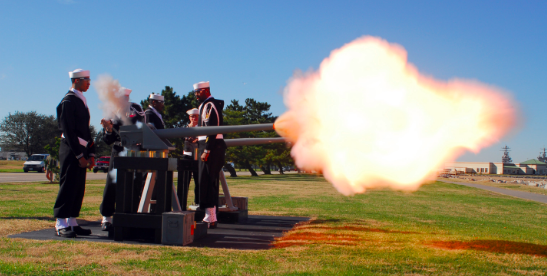Why We Give 21-Gun Salutes

When the President of the United States hosts a dignitary from abroad, it’s customary for the visitor to be greeted by a 21-gun salute. The same ceremony occurs at the funeral of a deceased president (here’s video from George H.W. Bush’s funeral) and at many other key moments of national importance. And the tradition isn’t limited to the United States. Nearly two-dozen nations have similar customs, shooting weapons into the air in honor of their own or a visiting leader.
But if you think about it, firing guns in this situation doesn’t make a lot of sense — you don’t want someone shooting a visiting Prime Minister, after all. (It’s a little less of an issue at a funeral, for obvious reasons.) Why do we do this? And why do we do this 21 times?
Like most traditions, this one used to make sense. And in this case, it pre-dates guns themselves.
According to Arlington National Cemetery’s website, “the tradition of saluting can be traced to the Middle Ages practice of placing oneself in an unarmed position and, therefore, in the power of those being honored.” Today, diplomacy is generally a peaceful endeavor; even nations which otherwise aren’t in each other’s good graces can find ways for their leaders to meet without bloodshed being the result. But that wasn’t always the case. In order to guarantee peace, warriors would lay down their swords before approaching a foreign dignitary. This ritual of pragmatism even entered the world of fiction; in Lord of the Rings, when Aragorn, Gandalf, Gimli, and Legolas pay a visit to the Sauraman-controlled King Theoden of Rohan, the Rohirrim guards insist that the quartet surrender their arms before entering. It makes a lot of sense — if you’re truly here on a mission of diplomacy, disarming yourself is a sign of good faith.
And while that works for swords, bows, axes, and staves, it doesn’t work that well for cannon — particularly not those on gunships. A ship simply can’t just toss its cannons overboard every time it comes into a port of questionable friendliness, after all. So another solution was in order: the cannons would fire a cannonball into the waters. This had the same effect as laying down one’s sword; as the U.S. Army for Military History explains, it took a while to reload a cannon, so “discharging them once rendered them ineffective.” And most likely due to superstition and a belief that the number seven was lucky, many ships carried seven cannons. Ships on a diplomatic mission, therefore, would give what in effect became a 7-gun salute. All that’s left is that we multiply by three.
That multiplier comes from the shore-based response to the 7-gun salute. Ships didn’t carry a lot of gun powder because if it got wet, it’d not be very useful. On the other hand, shore defenses often had plenty to go around. Firing off one shot wouldn’t be enough to disarm, so they had to fire off multiple. The Army’s website continues: “Land batteries, having a greater supply of gunpowder, were able to fire three guns for every shot fired afloat, hence the salute by shore batteries was 21 guns. The multiple of three probably was chosen because of the mystical significance of the number three in many ancient civilizations.”
Today, the tradition remains even though there’s no actual disarmament involved — in almost all cases, today’s saluting guns are firing blanks.
Bonus fact: When it comes to ships and superstitions, having seven cannons on board is hardly the weirdest one out there. Need another contender for that title? Fisherman typically ban bananas from their expeditions. In 2010, for example, ESPN asked fishing champion (yes, that’s a thing) Greg Hackney if he follows any superstitions; he replied by saying “I don’t fish with a banana in the boat” because he heard that doing so “was bad.” And that’s a pretty tepid response. In 2001, the LA Times interviewed a Florida-based fishing boat captain; the captain said “I check for bananas, then I check for Banana Boat sunscreen products, then for Banana Republic shirts and blouses, then for Starburst strawberry-banana [candies] and, most important of all, for Fruit of the Loom labels.” He was being very cautious: Fruit of the Loom’s logo does not contain bananas.
From the Archives: Shooting Fish Way Over the Barrel: Meet the salmon cannon.
